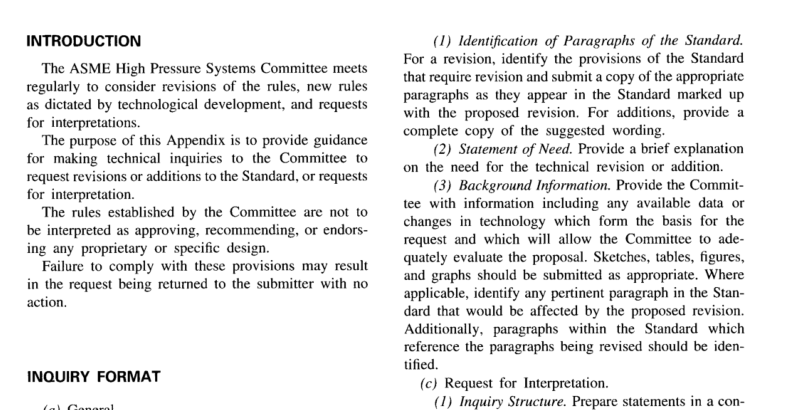ASME HPS-2003 pdf free download.PREPARATION OF TECHNICAL INQUIRIES TO THE HIGH PRESSURE SYSTEM COMMITTEE
The ASME High Pressure Systems Committee meets regularly to consider revisions of the rules, new rules as dictated by technological development, and requests for interpretations.
The purpose of this Appendix is to provide guidance for making technical inquiries to the Committee to request revisions or additions to the Standard, or requests for interpretation. The rules established by the Committee are not to be interpreted as approving, recommending, or endors- ing any proprietary or specific design. Failure to comply with these provisions may result in the request being returned to the submitter with no action
. INQUIRY FORMAT
(a) General
( I) Purpose. Specify one of the following purposes for the inquiry
(a) request for revision of present rules
(b) request for new (additional) rules
(c) request for an interpretation
(2) Background. Provide the information needed for the Committee’s understanding of the inquiry, being sure to include reference to the applicable Section, Edition, Addenda, paragraphs, figures, and tables.
(3) Presentations. The proposer may desire or be asked to attend a Committee meeting to make a formal presentation to the Committee or to answer questions the Committee may have in regard to the proposal.
(b) Request for Revision or Addition.
(1) Identijìcation of Paragraphs of the Standard. For a revision, identify the provisions of the Standard that require revision and submit a copy of the appropriate paragraphs as they appear in the Standard marked up with the proposed revision. For additions, provide a complete copy of the suggested wording.
(2) Statement of Need. Provide a brief explanation on the need for the technical revision or addition.
(3) Background Information. Provide the Commit- tee with information including any available data or changes in technology which form the basis for the request and which will allow the Committee to ade- quately evaluate the proposal. Sketches, tables, figures, and graphs should be submitted as appropriate. Where applicable, identify any pertinent paragraph in the Stan- dard that would be affected by the proposed revision. Additionally, paragraphs within the Standard which reference the paragraphs being revised should be iden- tified.
(c) Request for Interpretation.
(1) Inquiry Structure. Prepare statements in a condensed and precise question format, omitting superfluous background information, and, where appropriate, composed in such a way that “yes” or “no” (perhaps with provisos) would be an acceptable reply. This inquiry statement should be technically and editorially correct.
(2) Proposed Reply. State what it is believed that the Standard requires.
(d) Submittal. Inquiries shall preferably be submitted in typewritten form; however, legible handwritten inquiries will also be considered. They shall include the name and mailing address of the inquirer, and be mailed to the following address: Secretary, ASME High Pressure Systems Committee, Three Park Avenue, New York, NY 10016.
1100 SCOPE High Pressure Systems requirements shall augment the ASME Boiler and Pressure Code, Section VIII, Pressure Vessels and the ASME B3 1.3-Chemical Plant and Petroleum Refinery Piping Code. These require- ments for High Pressure Systems exclude nuclear power applications.
These provisions were developed because of the high stress conditions usually imposed on equipment in high pressure applications which generally present severe physical hazards by high energy releases in the event of equipment failure.
It is intended that these provisions cover those areas not already accommodated by existing standards and shall serve as standards for design, materials, fabrication, installation, testing, inspection, maintenance, documen- tation, replacement, repair, and protective containment of high pressure systems.
1200 DEFINITIONS
1210 High Pressure
High pressure for the purpose of these provisions, is generally considered to be any fluid pressure at and above 10,000 psi (69 MPa) but is not limited thereto.ASME HPS pdf download.ASME HPS-2003 pdf free download
